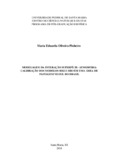| dc.creator | Pinheiro, Maria Eduarda Oliveira | |
| dc.date.accessioned | 2018-09-10T20:27:21Z | |
| dc.date.available | 2018-09-10T20:27:21Z | |
| dc.date.issued | 2018-02-08 | |
| dc.identifier.uri | http://repositorio.ufsm.br/handle/1/14242 | |
| dc.description.abstract | The Simple Biosphere Model (SiB) modelwas developed to represent and estimate the interactions
between soil, vegetation and atmosphere, which describe the transfer processes of energy, mass
and momentum. In this sense, this study goal is the optimization of the fluxes of energy, water
and carbon dioxide, estimated by the second and third versions of the SiB model (SiB2 and SiB3),
using experimental data obtained by the Eddy Covariance method. The study area is located
in the county of Santa Maria under the Pampa biome witch has pasture fields as characteristic
vegetation. In this area experimental measurements of atmospheric forcing of model initialization
and surface fluxes are obtained. The study period comprises the years of 2014 to 2016. First, a
soil respiration equation was inserted into the SiB2 model, which is calibrated from observed
night data of CO2 flux, soil and air temperature, and soil moisture. Then the soil and vegetation
parameters were calibrated by the sequential modules method in the SiB2 and SiB3 models. This
method consists of the calibration of each parameter following the execution sequence of the
calculations in the models. The the optimal parameter was obtained through the Nash-Suticliffe
efficiency (NSE). The calibration performed sought to optimize all three fluxes simultaneously.
The same atmospheric variables that strongly influence the observed fluxes, also influence in
equal proportion, the modeled fluxes. Therefore, it is inferred that the representation of the
vegetation by the models is insufficient for the study area. The results obtained in this research
were satisfactory. Thus, the parameters calibrated in this work can be used as representative
parameters of the Pampa biome in surface models as well to evaluate the changes of land use in
this ecosystem. | eng |
| dc.language | por | por |
| dc.publisher | Universidade Federal de Santa Maria | por |
| dc.rights | Attribution-NonCommercial-NoDerivatives 4.0 International | * |
| dc.rights.uri | http://creativecommons.org/licenses/by-nc-nd/4.0/ | * |
| dc.subject | Modelo SiB2 | por |
| dc.subject | Modelo SiB3 | por |
| dc.subject | Bioma Pampa | por |
| dc.subject | Fluxos superficiais | por |
| dc.subject | Model SiB2 | eng |
| dc.subject | Model SiB3 | eng |
| dc.subject | Pampa biome | eng |
| dc.subject | Surface fluxes | eng |
| dc.title | Modelagem da interação superfície- atmosfera: calibração dos modelos sib2 e sib3 em uma área de pastagem no sul do Brasil | por |
| dc.title.alternative | Surface-atmosphere interaction modeling:sib2 and sib3 models calibration in a grassland area in south Brasil | eng |
| dc.type | Dissertação | por |
| dc.description.resumo | O modelo Simple Biosphere Model (SiB) foi desenvolvido para representar os ecossistemas e
estimar as interações entre o solo, a vegetação e a atmosfera, que descrevem os processos de
transferência de energia, massa e momentum. Nesse sentido, este estudo tem como objetivo
otimizar os fluxos de energia, água e CO2, estimados pela segunda e terceira versões do modelo
SiB (SiB2 e SiB3), tendo como referência dados experimentais obtidos pelo método Eddy
Covariance. A área de estudo está localizada no município de Santa Maria dentro do bioma
Pampa e possui, como vegetação característica, campos de pastagem. Nessa área foram obtidas
medidas experimentais das forçantes atmosféricas de inicialização dos modelos e os fluxos
superficiais. O período de estudo compreende os anos de 2014 à 2016. Primeiramente, foi
inserida uma equação da respiração do solo no modelo SiB2, calibrada a partir de dados
noturnos observados do fluxo de CO2, da temperatura do solo e do ar e da umidade do solo.
Em seguida foram calibrados os parâmetros de solo e vegetação pelo método dos módulos
sequenciais nos modelos SiB2 e SiB3. Este método consta da calibração de cada parâmetro
seguindo a sequência de execução dos cálculos nos modelos. A escolha do parâmetro ótimo foi
obtida através da eficiência de Nash-Suticliffe (NSE). A calibração realizada buscou otimizar os
três fluxos simultaneamente. As mesmas variáveis atmosféricas que influenciam altamente os
fluxos observados, também influenciam em igual proporção, os fluxos modelados. Portanto, a
representação da vegetação pelos modelos SiB2 e SiB3 pode estar influenciando negativamente
a estimativa dos fluxos superficiais. Os resultados obtidos nessa pesquisa foram satisfatórios.
Dessa forma, os parâmetros calibrados neste trabalho poderão ser utilizados como parâmetros
representativos do bioma Pampa em modelos de superfície, bem como, avaliar as mudanças do
uso da terra neste ecossistema. | por |
| dc.contributor.advisor1 | Roberti, Débora Regina | |
| dc.contributor.advisor1Lattes | http://lattes.cnpq.br/6952076109453197 | por |
| dc.contributor.referee1 | Teichrieb, Claudio Alberto | |
| dc.contributor.referee1Lattes | http://lattes.cnpq.br/9616939649732127 | por |
| dc.contributor.referee2 | Llopart, Marta Pereira | |
| dc.contributor.referee2Lattes | http://lattes.cnpq.br/1940372839155036 | por |
| dc.creator.Lattes | http://lattes.cnpq.br/1038705051572000 | por |
| dc.publisher.country | Brasil | por |
| dc.publisher.department | Física | por |
| dc.publisher.initials | UFSM | por |
| dc.publisher.program | Programa de Pós-Graduação em Física | por |
| dc.subject.cnpq | CNPQ::CIENCIAS EXATAS E DA TERRA::FISICA | por |
| dc.publisher.unidade | Centro de Ciências Naturais e Exatas | por |



